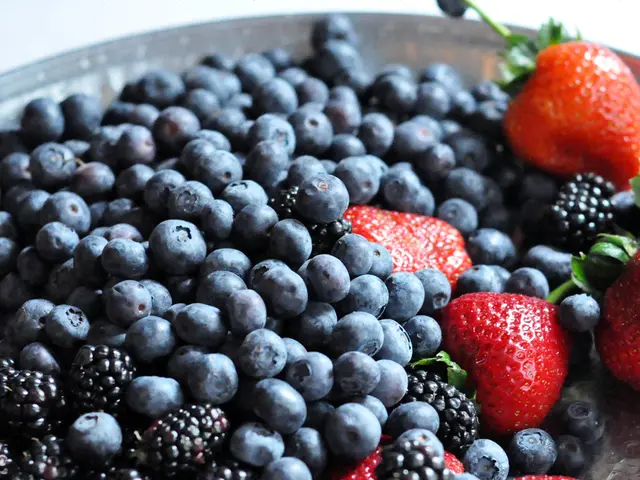Taking a Sip Towards Healthy Brains: The Magic of Caffeic Acid From Coffee Grounds
Preventative Measures for Parkinson's and Alzheimer's Discovered in Coffee Remnants
Caffeic acid, a marvel from Mother Nature's pantry, has long been recognized for its anti-inflammatory and antioxidant properties. These properties make it a potential powerhouse in the battle against neurodegenerative disorders, such as Parkinson's and Alzheimer's.
Caffeic acid can be found in the popular morning beverage we adore - coffee. Derived from chlorogenic acid, caffeic acid might just be the star ingredient behind coffee's extensive health benefits.
A team of researchers at the University of Texas's Department of Chemistry and Biochemistry has discovered that caffeic acid may lead to the development of a life-saving recipe for diseases like Parkinson's and Alzheimer's - by successfully bypassing the blood-brain barrier.
Your Daily Java: The Secret Ingredient You Didn't Know You Needed
Caffeic acid belongs to the polyphenol family, a group of plant-based compounds appreciated for their antioxidant abilities. Mahesh Narayan, Ph.D., a professor at the Department of Chemistry and Biochemistry and a Fellow of the Royal Society of Chemistry, emphasizes that the unique trait of caffeic acid is its ability to penetrate the blood-brain barrier.
Intriguingly, carbon quantum dots (CQDs) are created when heat is applied to materials like coffee, coffee grounds, fish, fruit peels, or waste paper. CQDs, however, do not exist naturally. Instead, they are synthesized from these materials.
In their latest study, the Texas team found that caffeic acid-based Carbon Quantum Dots (CACQDs), derived from spent coffee grounds, show potential in protecting brain cells from damage caused by neurodegenerative diseases. When exposed to factors such as obesity, age, or exposure to pesticides and other toxic chemicals, these CACQDs prove to be neuroprotective.
Sign up for Peak Longevity Platinum to boost cellular energy and upgrade your health!
Battling Brain Disorders at the Root Cause
Researchers led by Jyotish Kumar observed that brain disorders triggered by lifestyle and environmental factors share common traits, such as elevated free radical levels and the aggregation of amyloid-forming protein fragments potentially leading to plaques or fibrils in the brain. The team found that CACQDs are capable of removing free radicals or preventing them from causing damage and successfully curb the aggregation of amyloid protein without causing significant side effects.
Kumar expressed optimism that CACQDs could be revolutionary in treating neurodegenerative disorders. As existing treatments focus on alleviating symptoms, Kumar’s team is working tirelessly to find a cure by studying the atomic and molecular underpinnings that drive these conditions.
The (Almost) Magic of Other Foods
While creating equally effective CQDs from other food sources is not as straightforward, some foods contain caffeic acid. Red wine, herbs like thyme, sage, and spearmint, spices like Ceylon cinnamon and star anise, sunflower seeds, apple sauce, apricots, prunes, black chokeberry, and yerba mate are among the moderate to high sources of caffeic acid.
Even though spent coffee grounds remain the optimal source for CQDs due to their high caffeic acid content, regularly enjoying a cup of coffee—especially when prepared with heat—proves to be a simple and affordable preventative measure against neurodegenerative diseases.
Discover Peak Chelation+ Resveratrol to flush harmful toxins from your body and stay healthy!
Harnessing the Power of CACQDs
Researchers believe that with early intervention, treatments based on CACQDs could effectively prevent full-blown neurodegenerative diseases like Alzheimer's or Parkinson's. Early treatment is crucial because addressing these disorders before they reach the clinical stage is vital for successful management.
If you’re regularly on the coffee train, you’re already warding off these diseases and enjoying the benefits of CACQDs. Just remember, if you're brewing your coffee using heat, you'll find the protective CACQDs in your cup. Reusing your spent coffee grounds for a second brew in the same day will increase the level of protection even more.
From cake to fruit, there's no limit to the ways you can incorporate coffee into your daily life.
Soothe your digestion and boost your energy levels with Peak Organic Superfruits!
Sources:
- Caffeic acid recarbonization: A green chemistry, sustainable carbon nano material platform to intervene in neurodegeneration induced by emerging contaminants - Environmental Research
- Coffee grounds may hold key to preventing neurodegenerative diseases - Science Daily
The alkaline secret to ultimate vitality: Revive your life today!
The Peak Way: Timeless, holistic, and transformative wellness solutions
- The unique trait of caffeic acid, a compound found in coffee, is its ability to penetrate the blood-brain barrier, making it a potential candidate for developing treatments against neurological disorders like Alzheimer's and Parkinson's.
- In addition to coffee, other food sources of caffeic acid include red wine, herbs such as thyme, sage, and spearmint, spices like Ceylon cinnamon and star anise, sunflower seeds, apple sauce, apricots, prunes, black chokeberry, and yerba mate.
- Research suggests that treatments based on Carbon Quantum Dots (CQDs) derived from caffeic acid, particularly those produced from spent coffee grounds, could be effective in preventing and managing neurodegenerative diseases, providing evidence that targeting the root causes of these conditions may lead to breakthroughs in developing cures.







